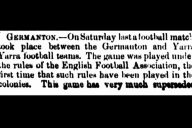I intended to write this piece later in the year. I really did. But all it took was one tweet from a notorious A-League killjoy to change that.
I am all for robust discussion about matters affecting the A-League, be they on the pitch or off the pitch, and the advent of social media has seen everyone with a brain, or even half a brain, jump in with their opinions.
But when the Secretary of the Football Media Association of Australia, an organisation that seeks to represent everyone on the football media pyramid — from the few professional journos at the pointy end to the growing mass of pimply “keyboard warriors” down the bottom — comes out with uninformed nonsense like this:
@MediaweekAUS: Fri TV #ALeague #WSWvBRI SBS2 59k SBS ONE 57k” If these numbers on FTA TV don't persuade us #ALeague is falling apart…
— Ezequiel Trumper (@EzequielTrumper) February 10, 2014
Well, I took the bait and bit back, only for Ezequiel to persist with his delusion:
@ArtSapphire I think some love football so much (and so do I) that they are in denial. TV ratings show #ALeague is failing, not me.
— Ezequiel Trumper (@EzequielTrumper) February 10, 2014
For those of you still confused by the exchange. I informed Ezequiel that last Friday’s Western Sydney Wanderers v Brisbane Roar match was watched by a combined Fox Sports and SBS Metro audience of 188,000 viewers (Pay TV ratings and SBS ratings from five major city markets, not including regional SBS viewers). A respectable result. It did not match the 274,000 that watched the battle between two of the best teams in the competition earlier in the season, but the match did clash with the final of cricket’s Big Bash League, which attracted over a million viewers, so you can expect a drop in audience numbers. Any reasonable person with an informed understanding of the A-League would agree.
Which is why I am now embarking on this journey, the one I had already planned, to do some research and inform you the reader on the real state of play on the health of the A-League’s TV ratings. Rather than falling into the easy trap of comparing the A-League to the major sporting codes in Australia – AFL, NRL, cricket. I cast my eyes across the Pacific, to the USA, to another football competition, Major League Soccer.
Just like the A-League, MLS is trying to gain a stubby toehold in an even more congested sporting market with not only a non-mainstream product, but an inferior product when compared to other football leagues around the world.
The A-League being in a smaller market with fewer major population centres does have an advantage when it comes to getting traction with viewers interested in football and also the wider sporting public.
Just how difficult it has been for the MLS can clearly be seen in the TV figures for the just completed 2013 season.
In the first regular season since the departure of David Beckham, sportsbusinessdaily.com reported:
“Audiences for the 20 matches on ESPN/ESPN2 in 2013 — mostly on Sunday evenings — dropped 29 percent, from an average of 311,000 in 2012 to 220,000 this season. The decline comes one season after ESPN had its best MLS numbers since the league’s inception in 1996. Across 37 MLS games, NBCSN averaged 112,000 viewers this season, an 8 percent decrease from 2012.”
MLS has a third American broadcast partner, UniMás, a Spanish language channel. UniMás bucked the trend in 2013 and registered a 6% increase. They aired 23 MLS regular season games with an average of 223,000 viewers.
The startling thing about these figures is how miniscule they are in the huge American television market.
ESPN & ESPN 2 is available in 97 million homes. NBCSN is available in 77 million homes.
On ESPN for example, a Monday night NFL match can attract up to 15 million viewers, a big College Football (American) match or NASCAR race 4 to 5 million viewers.
How do these figures compare to the A-League?
Fox Sports in Australia has the rights to broadcast all 135 regular season matches.
With two thirds of the season completed, A-League matches are averaging 70,000 on Fox Sports. (Australian sports market heavyweight NRL (Rugby League) averaged 240,000 on Fox Sports in 2013.)
Fox Sports is only available in around 2.5 million homes (30% of Australian homes) due to the low take-up rate of Pay TV in Australia, whereas MLS on ESPN is available in 85% of American homes.
As of the 2013/14 season, Friday night A-League matches are also being broadcast on Australian free to air television via SBS. This means Australia’s 8 million homes are now able to watch one A-League match a week, simultaneously broadcast by both Fox Sport and SBS.
After 18 weeks, audiences for Friday night matches are currently averaging 170,000 viewers (Pay TV ratings and SBS ratings from five major city markets, not including regional SBS viewers). With a paucity of blockbuster games between now and the end of the season and competition from other football codes, I expect the average figure to finish around 160,000 at the end of round 27 of the regular season.
This is only 60,000 less than the 220,000 average for the 20 regular season MLS games on ESPN. Yet, MLS matches on ESPN are broadcast to a potential audience 12 times larger (8 million homes v 97 million homes) than Friday night A-League matches in Australia.
In other words, for the MLS to achieve similar television market penetration in the US as the A-League in Australia they need to average 2 million viewers on ESPN. For MLS officials this is a Cheech-and-Chong-sized pipe dream. It is no surprise then that the current MLS TV deal — ESPN (US$8 million), NBC (US$10 million) and Univision (US$9 million) — is similar to the A-League component of the FFA’s current TV rights deal when potentially it can be much, much more.
It gets much worse when you compare the 2013 A-League Grand Final with the MLS Cup.
The 2013 MLS Cup between Sporting Kansas City and Real Salt Lake was watched by only 505,000 viewers on ESPN (797,000 in 2012). Blushes were spared when UniMás recorded 514,000 viewers (485,000 in 2012).
All up the 2013 MLS Cup attracted 1,019,000 viewers in the US compared to the 1,282,000 that watched Beckham’s LA Galaxy v Houston Dynamos MLS Cup swansong in 2012.
The 2013 A-League Grand Final between Western Sydney Wanderers and Central Coast Mariners attracted an Australian audience of 296,000 viewers. The match was broadcast only on Fox Sport which meant it could only be seen in 2.5 million Australia households. It was the 2nd most watched program on Australian Pay TV that week, just behind 298,000 that watched an Australian Rules match between Sydney and Geelong; a clash involving two of the AFL’s strongest teams.
The MLS Cup Final on ESPN, on the other hand, was the 97th most watched program, not on American Pay TV, but just on ESPN for the week Dec 2-8; less than PBA Ten Pin Bowling, which came in 95th place.
And when just as many people tune in to watch fictional sportswriter Raymond Barone in a repeat of Everybody Loves Raymond during the second half of the MLS Cup, then you know you have a problem.
During the course of my journey I have stumbled across some excellent pieces on sites like The Shin Guardian and The Big Lead suggesting ways MLS and broadcasters can improve TV ratings.
I also discovered that Americans are proportionally bigger Eurosnobs than Australians.
“NBC, which paid $250 million to acquire Premier League rights, averaged 390,000 viewers for its early-season broadcasts and saw almost a million tune in for the Everton/Chelsea match in mid-September and Sunday’s Manchester United/Arsenal game on NBCSN averaged over 800,000 viewers — numbers that certainly must make MLS executives cringe,” wrote Mike Cardillo in The Big Lead.
In Australia, there is no discernible discrepancy between the number of people who watch A-League compared to EPL.
CONCLUSION
Is the A-League failing in terms of TV ratings — NO.
Although, there is scope for improvement by scheduling the competition’s more attractive fixtures on Friday nights. The best promotion for the A-League, the Melbourne and Sydney derbies, are yet to appear on free to air television. This must be rectified next season.
Will Ezequiel still be sending tweets from his penthouse in football cloudcuckooland — MORE THAN LIKELY.

















Congratulations on your well written and researched piece.
I wish to clarify one piece and one piece only.
I tweet solely on behalf of myself The fact that I am the secretary of Football Media Association (a voluntary role) is irrelevant. After all, other members of the FMA Committee tweet their opinions and there is no assumption on their behalf that they are FMA views. Ray Gatt, Bonita Mersiades and others tweet regularly (and publish in various prestigious publications) and nobody I have seen has ever attributed their views to the FMA. I am no different
Amongst other things, FMA holds the belief that people have the right to express their opinion.
It is not FMA’s role to have an organisational opinion on these issues one way or the other and we do not endorse any one’s comments one over another. What we do endorse is the right of anyone to express his views and the right of you (or anyone else) to express your opposition.
The objectives of FMA are set out here: http://www.footballmedia.org.au
Kind Regards (and congratulations of your articles and the website)
Ezequiel Trumper
Thanks for the kind words about the piece and the website, Ezequiel. Much appreciated.
This article just shows one thing: the A-League in Australia is bigger than NHL(and NBA, potentially) in USA. Congrats!
MLS will still get much larger TV deal(presumably $110M+/year starts from 2015 season ) in the end. Suck it, small country. HA
Sorry to be negitive but I can understand why people post negitive comments about A-league tv ratings last session Fox Sports had its best ever ratings for the A-league and there was a lot of hype with games being shown on SBS for the first time and in my view SBS have underperformed and they have failed to grow as the session progresses and Fox Sports figures remain repectable but have also flattened out. There is still hope for a strong finish to the session but at the moment I was expecting SBS to have a bigger impact.